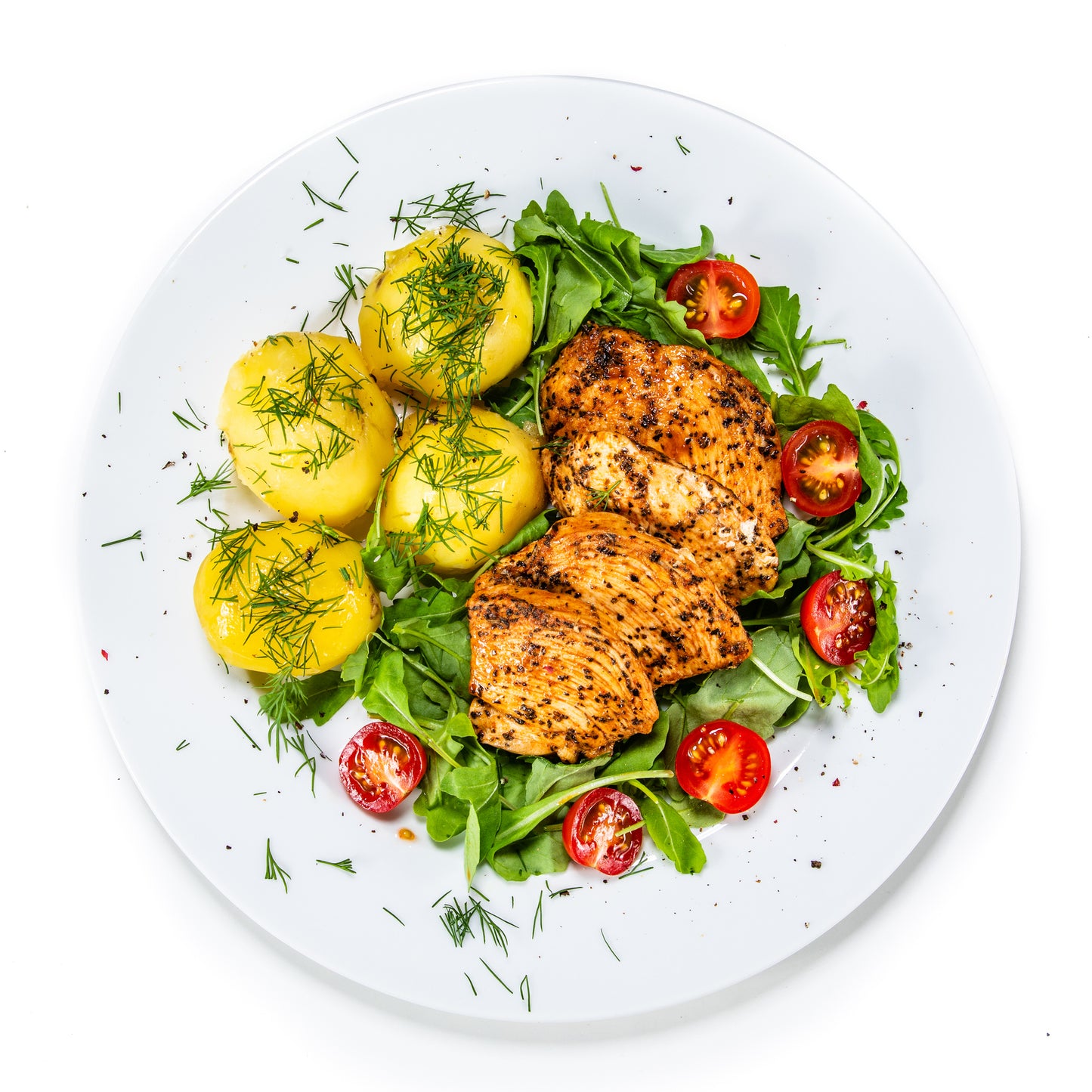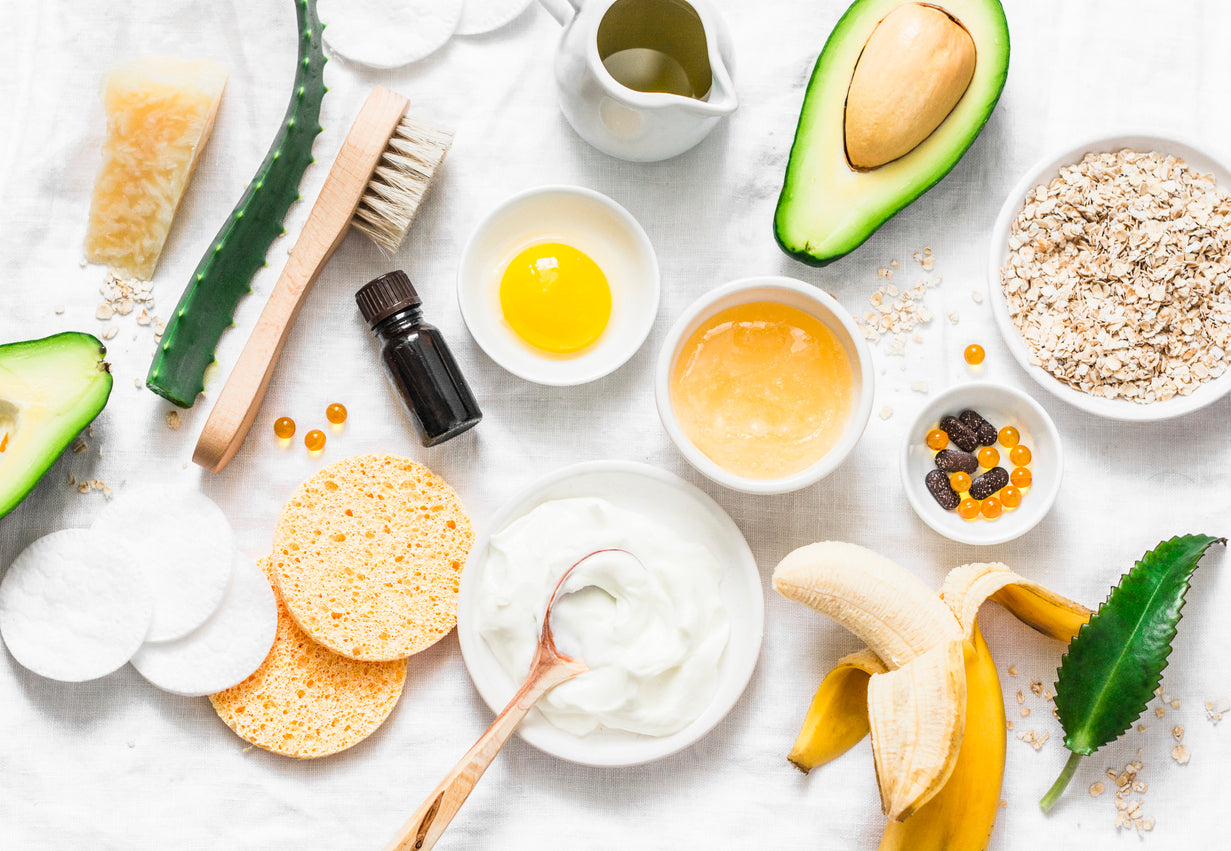
How to Create a Healthy Meal for Weight Loss
If there’s one myth that I want to bust, it’s that eating healthy is hard. It isn’t! In fact, creating a healthy meal doesn’t have to be complicated at all. I’ve spent years teaching my patients that the simple key to losing weight is learning how to assemble a meal with the right portions of protein, healthy fat, and carbohydrates. And if that still sounds confusing to you, don’t worry, I’m here to help.
Focus on lean, natural protein
The first step is to focus on lean, natural protein. These days, millions of people — and women in particular — are seriously shorting themselves on this important macronutrient. That’s bad news because you need an adequate supply of protein to build lean muscle, keep your body slim, stabilize your blood sugar, boost your energy, and keep your brain firing at optimal speed!
My favorite choices include:
- Wild-caught salmon and other fatty fish
- Pastured beef
- Free-range poultry and eggs
- And grass-fed lamb
Yes, there are healthy fats
If you know me, you know that I’m on a crusade to overturn the decades-old idea that “low-fat” means healthy. In reality, healthy fats help you burn more fat—and in addition, they build strong skin cell walls (bye-bye, wrinkles!) and support hormone optimization. The trick here is to make sure you avoid seed oils that are high in omega-6 fatty acids and instead, reach for fats like coconut oil, avocado oil, olive oil, and clarified butter.
Other great sources of healthy fats include:
- Olives
- Avocados
- Unsweetened coconut chips
- Canned coconut milk
- Nuts
- Hemp seeds
- Flaxseed
- And chia seeds
Not all carbohydrates are created equal
It’s true that carbs get a bad rep, but not all carbs are bad! The key to success is understanding which are the right carbs for you. I recommend focusing most of your diet on non-starchy vegetables while finding a balance with a smaller portion of starchy vegetables. But what’s the difference?
Non-starchy veggies are rich in fiber and nutrients that sweep out toxins and revitalize your cells. They also fill you up, making it easier to resist a cookie or candy bar. So it’s important to load your plate with non-starchy veggies every day.
My favorite go-to non-starchy vegetables are:
- Leafy greens
- Cucumbers
- Zucchini
And cruciferous vegetables, like:
- Broccoli
- Cauliflower
- Cabbage
- And bok choy
Starchy veggies like carrots, beets, and sweet potatoes are also packed with nutrients, but I want you to eat them more sparingly because they’re higher in carbohydrates. Enjoy them on days when you need a little extra burst of energy — and think of them as accents for your meals, not as the stars of your plate. And if you’re looking to lose weight, be sure to follow my portion guidelines very closely when it comes to starchy vegetables.
Also, be sure to include fermented vegetables like kimchi and sauerkraut in your diet, because they supply your gut with healthy microbes that make it glow.
But should I count calories or macros?
Quick fact: Calories are a unit of measurement for food and counting calories is a method used to keep track of how much food you are consuming on a daily basis.
Now, just counting calories doesn’t account for the nutritional value of food. This is simply because not all food is created equal! For example, a 100-calorie pretzel snack pack does not hold the same nutritional value as a 100-calorie apple — with the apple you‘ll be getting those essential vitamins, minerals, and fiber that your body desperately craves. But the pretzels? Not so much. Another great example is that a 4.5-ounce chicken breast and a Snickers bar contain the same amount of calories but the Snickers bar has 20 grams of sugar and the chicken breast is sugar-free! Plus, the chicken breast has the clean protein your body needs.
Why do you care? Because what you eat matters. You won’t lose weight by simply counting calories (at least not long-term) if you’re constantly eating “dirty” foods.
Again, it may sound difficult, but the concept is pretty easy to understand, really: Processed foods don’t contain all the nutrients required to fill you up, therefore they tend to make you overeat, which ends up in weight gain. Cleaner, high protein, and high fiber foods however, will fill you up with nutrients, therefore curbing your hunger for longer periods of time, and making you much less likely to overeat.
Which is why macros are so important, and what I want to educate you more about. Macros, a.k.a. Macronutrients, are the carbohydrates, proteins, and fats in our diet, and they each have a certain number of calories per gram:
- Carbohydrates contain 4 calories per gram
- Protein contains 4 calories per gram
- Fat contains 9 calories per gram
Counting macros is another popular way to track your food consumption, and it makes sense why. Personally, I am more of a fan of counting macros than counting calories because it helps you see where your diet could be unbalanced, and what category you may need more or less of.
Bottom line, if you are familiar with and enjoy measuring, counting, and tracking, I say go for it. But if you’ve never done it, or are sick of doing it, I recommend learning to eyeball portions. Here’s how I teach my patients to understand what a portion of protein, fat, or carbohydrates looks like.
How to estimate the right portion size...

Protein Portions
- A serving of meat, fish, or poultry should be about the size and thickness of your palm.
- A serving of eggs is as many as you can hold in your hand (that’s two or three for women, three or four for men).
- Each meal should include one to two servings of protein.
Non-starchy Vegetable Portions
A serving of non-starchy vegetables should be at least the size of a softball. These are fabulous for you, so, if possible, fill your plate with at least two or three softballs worth!
Starchy Vegetable Portions
A serving of starchy vegetables (such as sweet potato, jicama, kohlrabi, or winter squash) should be about the size of a baseball for women and the size of a softball for men. Eat these sparingly, saving them for when you need an extra shot of energy.
Fat Portions
- A serving of oil or clarified butter is 1 tablespoon.
- A serving of nuts, seeds, coconut flakes, or olives is about 1 closed handful.
- A serving of nut butter is 1 tablespoon.
- A serving of avocado is 1/ 4 to 1/ 2 an avocado.
- A serving of coconut milk is 8 ounces, or 1/ 3 to 1/ 2 the can.
- A serving of almond milk is 8 ounces.
- A serving of chia seeds is 4 teaspoons.
- A serving of flaxseed is 2 tablespoons.
- A serving of hemp seeds is 2 tablespoons.
Fruit Portions
A serving of fruit is half an individual piece (half an apple, half an orange) or a tennis ball–size serving of berries, grapes, or tropical fruits. That’s a closed handful, or about 1/2 cup if they’re diced. Eat no more than two servings of fruit per day, and break them up across meals and snacks to distribute your sugar intake.
Remember: Grapefruit and berries are best!
Putting together a healthy meal
Now that you understand how to estimate your portion sizes it’s time to assemble the perfect meal!
- Start with protein: have 1 to 2 servings of protein at each meal.
- Add lots of non-starchy vegetables and a smaller serving of starchy vegetables
- Use 1 to 2 servings of healthy fats when cooking meals or adding dressing to a salad or bowl

What about grains, rice, beans, and lentils?
My message has always been anti-gluten and mostly anti-grain, and here’s why: Our modern-day farming and processing of grains has turned most grains, and especially wheat, into anti-nutrient, sugar-spiking, processed foods.
The bread and pasta on the shelves these days are nothing like the bread that our early ancestors or even our grandparents ate. Plus, most people don’t know how to put the brakes on when it comes to their favorite comfort foods like bread, pasta, cookies, and cake. Too often, people see it as an all-or-nothing thing — in for a penny, in for a pound. So I typically recommend grains be avoided altogether.
But I’ll be honest, even I like to have something a little off-plan now and then (that’s where my 80/20 rule comes in handy)! And while I mainly stick to non-GMO corn tortillas or an occasional slice of Ezekiel bread, I know some people want more options than that. So, if you’re going to venture into the world of grains, go for things like barley, rice, rye, or spelt. I also recommend sticking to organic, non-GMO grains and — even better — choosing grains that are ancient, sprouted, and/or fermented.
While I love legumes, beans, and lentils, for their fiber content they are pretty high in carbs and hard for our bodies to digest. Beans are also high in lectins and can be damaging to your gut health. That said, it’s true that many people handle legumes just fine. If you’re one of them, they can be a healthy part of your diet, just make sure you’re monitoring how many carbohydrates you are consuming when eating these foods with your meal.
The bottom line here: grains and legumes are high in carbs and easy to over-induldge in.
What about fruit?
When looking to lose weight, I recommend limiting fruits because they are higher in sugar than non-starchy vegetables. However, there are two fruits — grapefruit, and berries — that are such fantastic powerfoods that I consume them most days as a small snack.
Grapefruit is packed with a compound called nootkatone, which supports fat-burning, and berries (especially blueberries) are loaded with nutrients that support healthy blood sugar and blood pressure levels, and even have protective properties for sun damage!
One note: Grapefruit can interact with many medications, increasing their potency. If you’re taking any medications right now, check with your doctor or pharmacist to make sure it’s safe for you to include grapefruit in your diet.
Controlling your carbohydrate intake
So, I’m sure you’re seeing a theme here… and that is to watch your carbohydrate intake! Here’s why I am always driving the low-carb message home: The starches and sugars in carbs get absorbed rapidly and are converted to glucose, causing your blood sugar and insulin levels to spike, which packs on the pounds. That's the bad news.
The good news is, not all types of carbs affect you the same way! In fact, simply learning to count your carbs, and focusing on net carbs, can help you enjoy some of your favorite carbs — without gaining weight.
To calculate net carbs, use this equation:
Total Carbohydrates - Dietary Fiber - Sugar Alcohols = Net Carbs
Why does fiber matter? Fiber and sugar alcohols, like erythritol, are absorbed slowly (or not at all) and metabolized differently. As a result, they don’t cause your blood sugar and insulin levels to rise.
Here are my guidelines for daily carbohydrate intake.
If you want to:
- Lose weight: 50 to 75 net carbs (go lower as needed)
- Maintain weight: 75 to 150 net carbs
- Gain weight: 150 to 200 net carbs
So, if you keep your total net carb intake within the 50 to 75 range (15 to 25 carbs per meal) you can easily lose weight and still enjoy some of your favorite foods.
One final tip…
I do have a “free” food that you can enjoy every day, with meals or as a snack!
It’s delicious, comforting, and has a multitude of health benefits…
It’s bone broth!
Bone broth has always been the cornerstone of my weight loss and healthy lifestyle plans because it’s filling, loaded with nutrients and protein, and very low in carbs or no-carb. And did you know? Bone broth is also great for curbing sugar cravings! Plus, thanks to the protein, it helps you stay fuller longer, meaning that even if you do get a craving for those sugary drinks and snacks, you can rely on bone broth to fill you up, without adding on the pounds!
I promise if you follow the guidelines above you can effortlessly lose weight and keep it off. And as a bonus, when you add bone broth to your daily routine you’ll experience improvements in your skin, hair, nails, sleep, energy levels, and even your joints!
So what are you waiting for? Check out my Collagen Bone Broth and kickstart your transformation today!









